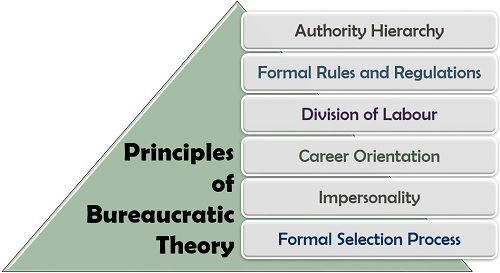Bureaucratic Management Includes Which of the Following Components
Webers guidelines for bureaucratic design include. The high degree of Division of Labor and Specialization.

Bureaucratic Management Theory Explained Max Weber Youtube
All of the following are names given to bureaucratic offices except.

. Authority divided among several managers. Organization ____ refers to the manner in which an organizations structural components are arranged to manage the total organization. The practical lessons of scientific management include all of the following EXCEPT.
Customer relationship management C. Terms in this set 6 specialization. The three important environmental challenges of international management include economic political legal and cultural challenges.
Presidential aides bureaucratic agencies and interest groups. Clear division of labour. ______ refers to the situation where bureaucratic agencies that are supposed to regulate business and industries are staffed by individuals with close ties to the very firms that they are supposed to be regulating.
Clear hierarchy of authority. The bureaucratic organization is very organized with a high degree of formality in the way it operates. Assigns individuals highly specialized jobs.
An integrative approach to management that supports the attainment of customer satisfaction through a wide variety of tools and techniques that result in high-quality goods and services is. Bureaucracies arrange workers in a vertical ranking creating a pyramid. An agency that supports the chief executive and other administrators.
The process of systematically organizing work i nto tasks is involved in. All of the following are members of the bureaucracy except. From the principles of bureaucratic organization we can find these characteristics or features of Bureaucratic Organization are as follows-.
Unfortunately when taken to extremes the same concepts became associated with red. These elements make up max Weber s six principles of bureaucracy. Select workers with the right abilities to do the job.
Below is a more detailed explanation of the bureaucratic management principles. Executive departments interest groups and state legislatures C. Bureaucratic principles which include.
A clearly outlined organizational hierarchy impersonal relationships among organization members and which of the following. The political legal environment has four different components such as. Bureaucracy is a complex means of managing life in social institutions that includes rules and regulations patterns and procedures that both are designed to simplify the functioning of complex organizations.
A large complex structure that handles the everyday business of government. A complex means of managing life in social institutions that includes rules and regulations patterns and procedures that are designed to simplify the functioning of complex organizations. Bureaucracy includes three primary components.
The 6 bureaucracy characteristics are. Red tapethe mechanisms procedures and rules that must be followed to get something done. Independent regulatory agency IRAbureaucratic agency enforcing government regulationsrules.
Organise tasks into groups to encourage teamwork. Impersonal Impersonality and Personal Indifference Career orientation. Government stability incentives for international trade controls on international trade and economic communities.
Organise tasks into groups to encourage teamwork. A bureaucratic organization is a form of management that has a pyramidal command structure. Independent executive agency IEAbureaucratic agency providing information or service to the public.
Train workers and provide incentives to follow rules. A moving from flat to bureaucratic B moving from boundaryless to flat C moving from bureaucratic to flat D mocing from bureaucratic to boundaryless. Bureaucracies enacted rules and regulations to guide operation in order to operate in a predictable way.
Hierarchy job specialization division of labor formal rules procedures equality and recruitment on merit. Just-in time control JIT B. The definition of bureaucracy includes all of the following notions EXCEPT a.
Webers theory that a bureaucratic society would result in a situation in which it would be impossible to avoid. Congressional committees bureaucratic agencies and interest groups D. Weber and Fayol the original proponents of this style of management were fighting favoritism and incompetence common in large organizations at the time.
Asked Jun 6 2020 in Political Science by Jamie. They help to enhance organization capabilities by improving administrative and management systems through well defined rules. Bureaucratic management looks at how large organizations with layers of management can operate in an efficient rational manner.
A clear change of command. What are the three components of an iron triangle. Weber viewed the bureaucratic form of organization as all of the following except.
Webers conception of bureaucratic organizations included all of the following characteristics EXCEPT. It follows the principle of Rationality Objectively and Consistency. Task specialisation Specialization and Division of Labor Hierarchical layers of authority.
I Well defined rules ii Established hierarchy iii Standard operating procedures iv Good interpersonal relationships v Combined responsibility of completing work. Total quality management D. Which combination of the following characteristics correctly describes the Bureaucratic Administration.
Government officials interest groups and party leaders B. 10 Questions Show answers. Bureaucracy is a type of organizational or institutional management that is as Weber understood it rooted in legal-rational authority.
There is a well-defined chain of command.

Max Webers Bureaucracy Theory Concept And Principles Notes Videos Qa And Tests Grade 12 Business Studies Principles Of Management Kullabs

Bureaucratic Management Theory By Max Weber


Comments
Post a Comment